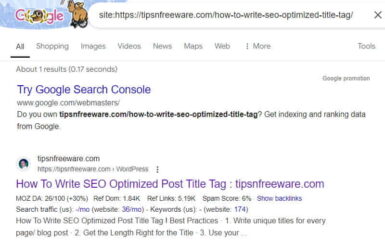Last updated on July 23rd,>>>
SEO (Search Engine Optimization) remains a cornerstone for achieving visibility and success online. For WordPress users, implementing effective SEO strategies is essential to drive organic traffic and improve search engine rankings.
Follow this comprehensive guide to master WordPress SEO and Improve Your Site’s Visibility.
6 DIY tips to enhance WordPress SEO
1. Optimize Your Site Structure
A well-structured website enhances user experience and makes it easier for search engines to crawl and index your content. Here are some steps to optimize your site structure:
:: Use SEO-Friendly URLs
Ensure your URLs are clean and descriptive. Avoid using complex strings and focus on incorporating relevant keywords. For example, instead of “yourwebsite.com/?p=123“, use “yourwebsite.com/seo-tips-2024”.
:: Create a Logical Navigation Menu
Organize your menu to reflect the hierarchy of your site’s content. Use categories and subcategories to create a logical flow, making it easier for visitors and search engines to understand your site’s structure.
:: Implement Breadcrumbs
Breadcrumbs provide a secondary navigation that helps users trace their path back to the homepage. They also enhance the site’s structure for search engines, improving indexing by search engines.
2. Mobile friendly website.
Everybody is in a hurry and mobile traffic surpasses desktop, Having a mobile-friendly site is a must and you can’t ignore it. Google and other search engines use mobile-first indexing, meaning it predominantly use the mobile version of the content for indexing and ranking.
Follow these tips to ensure your site is mobile-friendly.
:: Use a Responsive Theme. Choose a responsive WordPress theme that automatically adjusts to different screen sizes. This ensures a seamless experience for mobile users.
:: Optimize Images and Media
Compress images and use modern formats like WebP to reduce load times. Lazy-loading images can also improve performance on mobile devices.
See also How to easily optimize images for your website
:: Improve Site Speed
Utilize tools like Google PageSpeed Insights to identify and fix speed issues. Implement caching, minimize CSS and JavaScript files, and consider using a Content Delivery Network (CDN).
See also: How to speed up WordPress load time with FREE plugins.
3. Enhance Content Quality and Relevance
Content is king in the realm of SEO. High-quality, relevant content not only attracts visitors but also signals to search engines that your site is authoritative. Here’s how to enhance your content.
:: Conduct Keyword Research
Use tools like Google Keyword Planner, Ahrefs, or SEMrush to identify relevant keywords. Focus on long-tail keywords with lower competition to attract targeted traffic.
:: Create In-Depth, Valuable Content
Produce comprehensive content that answers your audience’s questions. Aim for long-form content (1,500+ words) that thoroughly covers the topic. Include multimedia elements like images, videos, and infographics to enrich the user experience.
:: Regularly Update Content
Keep your content fresh and up-to-date. Regular updates signal to search engines that your site is active and relevant.
4. Implement On-Page SEO Techniques
On-page SEO involves optimizing individual pages to rank higher and earn more relevant traffic. Here are key on-page SEO techniques.
:: Optimize Title Tags and Meta Descriptions
Craft compelling, keyword-rich title tags (50-60 characters) and meta descriptions (150-160 characters). These elements should accurately describe the page content and entice users to click.
:: Use Header Tags Wisely
Structure your content with header tags (H1, H2, H3, etc.). The H1 tag should include your main keyword and clearly state the page’s topic. Use H2 and H3 tags to break down the content into digestible sections.
:: Optimize Images
Add descriptive alt text to images, incorporating relevant keywords. This helps search engines understand the content of your images and improves accessibility.
:: Internal Linking
Link to other relevant pages on your site to guide users and search engines. This improves site navigation, distributes page authority, and increases the likelihood of indexing.
5. Leverage Technical SEO
Technical SEO focuses on the backend aspects of your site. Ensuring your site is technically sound can significantly boost your SEO efforts.
:: Enable XML Sitemaps
An XML sitemap helps search engines understand your site structure and find new content. Use plugins like Yoast SEO or Google XML Sitemaps to generate and submit your sitemap to search engines.
:: Use Schema Markup
Schema markup enhances your content’s visibility in search results by providing additional information to search engines. Implement schema to improve rich snippets and drive more organic traffic.
:: Fix Broken Links
Regularly check for and fix broken links. Use tools like Broken Link Checker to identify and resolve these issues, ensuring a smooth user experience and better SEO performance.
6. Build High-Quality Backlinks
Backlinks remain a crucial factor in SEO, signaling to search engines that your site is authoritative and trustworthy. To build high-quality backlinks.
:: Guest Blogging: Contribute high-quality articles to reputable sites in your niche. Ensure your guest posts provide value and include a link back to your site.
:: Outreach Campaigns: Reach out to influencers, bloggers, and industry experts to promote your content. Personalized outreach can help secure valuable backlinks.
:: Create Link-Worthy Content: Develop resources like infographics, comprehensive guides, and original research that others will want to link to.
:: Monitor Backlinks: Use tools like Ahrefs or Moz to track your backlinks and disavow any spammy or low-quality links that could harm your SEO.
6. Utilize SEO Plugins
SEO plugins can streamline the optimization process, offering tools and insights to improve your site’s performance. Here are some must-have plugins for WordPress SEO:
Yoast SEO
Yoast SEO is a comprehensive plugin that offers features like keyword optimization, readability analysis, and XML sitemap generation. It’s user-friendly and suitable for both beginners and advanced users.
Rank Math
Rank Math is another powerful SEO plugin that provides in-depth SEO analysis, keyword suggestions, and integration with Google Search Console. Its clean interface and robust features make it a popular choice.
All-in-One SEO Pack
This plugin offers a wide range of features including XML sitemap support, Google Analytics integration, and advanced canonical URLs. It’s a versatile tool for optimizing your WordPress site.
You might want to see 5 Best Alternatives to Yoast SEO WordPress Plugin
Conclusion
Optimizing your WordPress site for SEO involves a multifaceted approach, from site structure and mobile optimization to high-quality content and technical SEO. By implementing these six DIY tips, I am sure you can enhance your site’s visibility, drive organic traffic, and stay ahead of the competition.

Hello! I am Ben Jamir, Founder, and Author of this blog Tipsnfreeware. I blog about computer tips & tricks, share tested free Software’s, Networking, WordPress tips, SEO tips. If you like my post /Tips then please like and share it with your friends.







